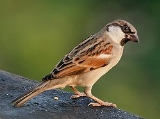
Passerine
Overview
A passerine is a bird
of the order
Passeriformes, which includes more than half of all bird species. Sometimes known as perching birds or, less accurately, as songbird
s, the passerines form one of the most diverse terrestrial vertebrate
orders: with over 5,000 identified species
, it has roughly twice as many species as the largest of the mammal
orders, the Rodent
ia. It contains over 110 families, the second most of any order of vertebrates (after the Perciformes
).
The names "passerines" and "Passeriformes" are derived from Passer domesticus, the scientific name of the type species
—the House Sparrow
—and ultimately from the Latin
term passer for Passer
sparrows and similar small birds.
The order is divided into three suborders, Tyranni
(suboscines), Passeri (oscines), and the basal Acanthisitti.
Bird
Birds are feathered, winged, bipedal, endothermic , egg-laying, vertebrate animals. Around 10,000 living species and 188 families makes them the most speciose class of tetrapod vertebrates. They inhabit ecosystems across the globe, from the Arctic to the Antarctic. Extant birds range in size from...
of the order
Order (biology)
In scientific classification used in biology, the order is# a taxonomic rank used in the classification of organisms. Other well-known ranks are life, domain, kingdom, phylum, class, family, genus, and species, with order fitting in between class and family...
Passeriformes, which includes more than half of all bird species. Sometimes known as perching birds or, less accurately, as songbird
Songbird
A songbird is a bird belonging to the suborder Passeri of the perching birds . Another name that is sometimes seen as scientific or vernacular name is Oscines, from Latin oscen, "a songbird"...
s, the passerines form one of the most diverse terrestrial vertebrate
Vertebrate
Vertebrates are animals that are members of the subphylum Vertebrata . Vertebrates are the largest group of chordates, with currently about 58,000 species described. Vertebrates include the jawless fishes, bony fishes, sharks and rays, amphibians, reptiles, mammals, and birds...
orders: with over 5,000 identified species
Species
In biology, a species is one of the basic units of biological classification and a taxonomic rank. A species is often defined as a group of organisms capable of interbreeding and producing fertile offspring. While in many cases this definition is adequate, more precise or differing measures are...
, it has roughly twice as many species as the largest of the mammal
Mammal
Mammals are members of a class of air-breathing vertebrate animals characterised by the possession of endothermy, hair, three middle ear bones, and mammary glands functional in mothers with young...
orders, the Rodent
Rodent
Rodentia is an order of mammals also known as rodents, characterised by two continuously growing incisors in the upper and lower jaws which must be kept short by gnawing....
ia. It contains over 110 families, the second most of any order of vertebrates (after the Perciformes
Perciformes
The Perciformes, also called the Percomorphi or Acanthopteri, is one of the largest orders of vertebrates, containing about 40% of all bony fish. Perciformes means perch-like. They belong to the class of ray-finned fish and comprise over 7,000 species found in almost all aquatic environments...
).
The names "passerines" and "Passeriformes" are derived from Passer domesticus, the scientific name of the type species
Type species
In biological nomenclature, a type species is both a concept and a practical system which is used in the classification and nomenclature of animals and plants. The value of a "type species" lies in the fact that it makes clear what is meant by a particular genus name. A type species is the species...
—the House Sparrow
House Sparrow
The House Sparrow is a bird of the sparrow family Passeridae, found in most parts of the world. One of about 25 species in the genus Passer, the House Sparrow occurs naturally in most of Europe, the Mediterranean region, and much of Asia...
—and ultimately from the Latin
Latin
Latin is an Italic language originally spoken in Latium and Ancient Rome. It, along with most European languages, is a descendant of the ancient Proto-Indo-European language. Although it is considered a dead language, a number of scholars and members of the Christian clergy speak it fluently, and...
term passer for Passer
Passer
Passer is a genus of Old World sparrows. These sparrows are plump little brown or greyish birds often with black, yellow or white markings. Typically 10–20 cm long, they have short tails and stubby conical beaks...
sparrows and similar small birds.
The order is divided into three suborders, Tyranni
Tyranni
The suborder of passerine birds Tyranni includes about 1,000 species, the large majority of which are South American. It is named after the type genus Tyrannus....
(suboscines), Passeri (oscines), and the basal Acanthisitti.
Unanswered Questions

